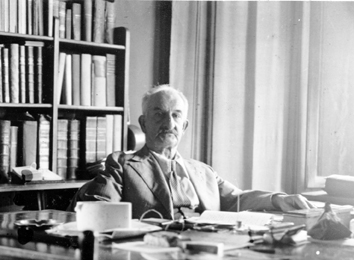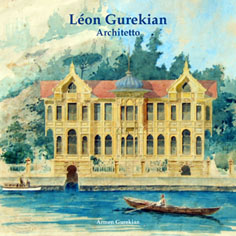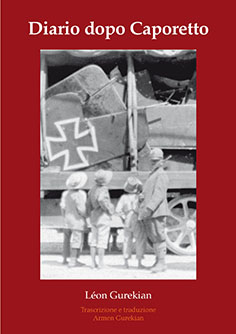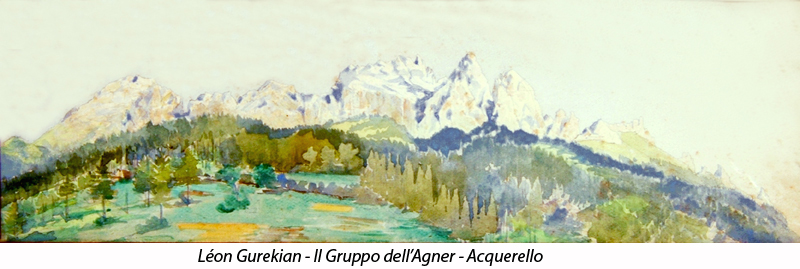 The Gurekian family was originally from Trebizond, on the Black Sea, where they dealt in commercial relations between the Middle East and Europe, mainly Marseilles, France.
The Gurekian family was originally from Trebizond, on the Black Sea, where they dealt in commercial relations between the Middle East and Europe, mainly Marseilles, France.Son of Hovhannés Gurekian and Prapion Yéremian, Léon Gurekian was born in Constantinople, on April 26, 1871.
He studied at the Mechitarist Fathers in Trebizond, and later at the Armenian Boarding School in Venice, Italy, where he graduated in 1888.
Léon enrolled at the Royal Institute of Fine Arts in Rome, and in 1895 he earned the licence to profess Architectural Design. In the same year he received a degree in Architecture from the Royal School of Engineering in Rome.
In 1896, soon after his return to Constantinople, Léon succeeded in finding refuge in Bulgaria to escape the anti-Armenian progroms by Sultan Abdul His university degree was recognized in Bulgaria by the local government. Theere, he designed various buildings, and he won the competition for the Varna Opera House which was subsequently built with slight modifications.
 After returning to Constantinople in 1899, L¶eacute;on designed and executed a remarkable number of buildings in Constantinople proper and in the Prinkipo islands.
After returning to Constantinople in 1899, L¶eacute;on designed and executed a remarkable number of buildings in Constantinople proper and in the Prinkipo islands.
Léon was friends with famed Architect Sarkis Balian, and he must have had contacts with his family's successors, since numerous original drawings of Balian's main projects were kept in the family's archives (drawings partly published - cfr: Pars Tuglaci, The role of the Balian family in Ottoman architecture, YCK, Istanbul 1990; Diana Barillari, Istanbul 1900; Firenze 1996, Octavo, Franco Cantini Editore). These drawings and photographs are now preserved in the Institute-Museum of Armenian Architecture in Yerevan.
In the meantime Léon was intensly engaged in political activity, writing for Armenian newspapers under a pseudonym.
In 1901, in Constantinople, he married Mariamik Azarian. In 1902 their only child, Ohannés was born.
On September 7, 1907, in a sudden fashion and without an apparent explanation, Léon moved to Rome, Italy.
In 1908 he received the degree of Professor of Architectural Design from the Institute of Fine Arts in Rome, on the basis of the coursework he did in 1895..
in1911 he designed and supervised the construction of the Ottoman Pavillion at the International exposition of Turin. This is one of the very few works he completed in Italy, along with a funerary chapel for a friend in Trieste, and his own house - "Villa Ararat" - in Asolo (Treviso).
In September 1911 he was appointed as the representative of the Ottoman Government at the International Architects Convention in Rome; however, since the war between the Ottoman Government and Italy had just started, Léon participated in the convention in a personal capacity, as a member of the Architect Association, of which he was already part.

During these years Léon spent more and more time in Asolo, where the summer residence of the Armenian Boarding School of Venice was located.
In 1912 Léon began a long survey of Byzantine and Romanesque monuments, in Ravenna, Acquileia, Istria, Dalmatia, and more so in the Lombardy area of Brianza, aimed at studying and understanding the influence of Armenian architecture over the Romanesque, ias a counterargument to Rivoira's. This documentation (The four notebooks) is now preserved in the Institute-Museum of Armenian Architecture in Yerevan.
Between 1914 and 1918 due to World War I he was forced to live in Asolo, where he made a living working as a photographer.
 In 1919 Léon was in Paris, where he published a political analysis of the WWI in the guise of an allegory titled "Le Responsable", and he was politically active advocating the establishment of an Independent Armenian Republic.
In 1919 Léon was in Paris, where he published a political analysis of the WWI in the guise of an allegory titled "Le Responsable", and he was politically active advocating the establishment of an Independent Armenian Republic.
In 1922, bitterly realizing the impossibility to return to what should have been the Independent Armenian Republic, given the failure of what the Versailles Treaty had ratified, Léon resolved to settle in Asolo, where he designed and built his own residence.
From that moment, he completely abandoned architecture. He published a series of political writings and philological essays, mainly in Armenian. In the last of these, "Kars and Ardahan" (1948), he asserted the full armenianness of those two regions, bestowed to Turkey.
At the end of World World II, a Delegation of the Soviet Armenian Republic went to Asolo to ask Léon if he was willing to move to Armenia. Already in poor health, Léon declined the invitation, and yet he would later point out: “Behind me there was always the photograph of General Antranik".

In 1921 he had started vacationing in Frassené, in the province of Belluno - and he continued to do so for years to come - because its nature and surroundings reminded him of the far away village of Toz, near Trebizond, where his family used to have a summer home. This would have a lasting impact on the life of their son Ohannés.
